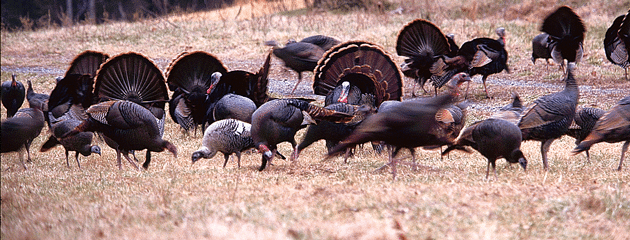
With Georgia’s turkey season opener just a few weeks away I thought it might be useful to put together some information about the thunder chickens that run around the woods and fields of Georgia and the rest of the country.
Wild Turkey (Meleagris gallopavo) is native to North America. In fact, it is only one of two species in its genus. There are six recognized subspecies of Wild Turkey. Those subspecies are the Eastern, the Osceola, the Rio Grande, the Merriams, the Goulds and the Ocellated wild turkey.
Eastern wild turkeys are the most abundant of all the turkeys. They can be found in 38 states and numerous Canadian provinces. The Osceola, which many contend is just an Eastern because it is defined geographically rather than as a separate genetic line, gets its name from where it is found. The Osceola can only be found in Florida. The Rio Grande wild turkeys are concentrated in the desert regions of Texas, Oklahoma, Kansas, and a few other western states. Mexico also is home to a healthy population. The Merriams are most abundant in the mountains of the West. The Rocky Mountains are considered the central hub of the population. The Gould’s can only be found in Arizona, New Mexico, and northern Mexico. The Ocellated turkey can only be found in the Yucatan Peninsula of Mexico, northern Belize and the El Petén region of northern Guatemala.
At the time of European contact, turkey populations were extremely abundant. There are a few reasons for this, first, was the Native American Indians reluctance to hunt them due to their position as spiritual symbols and the use of their feathers in ceremonial dress. The second was Indian land management practices. They often set fires to clear trees and undergrowth in order to create grasslands for deer and elk. The turkeys responded by increasing their populations dramatically. The numbers began to change by the 17th century as more and more Europeans had made their way to North America and viewed the wild turkey as a source of food. By the 1930’s the wild turkey had been hunted nearly to extinction, by market hunters. In 1973 the National Wild Turkey Federation was formed and after nearly 50 years of a conservation effort by hunters, Wild Turkeys have huntable populations in all of the lower 48 states and in Hawaii.
In the wild, turkeys range in size from 5 pounds to 30 pounds with an average of about 17 pounds and 40 inches tall. They can run about 25 mph and can fly at speeds over 55 mph. They have an average lifespan of about 2 and half years but lifespans of 3-5 are not uncommon and the oldest known wild turkey was 13 years old. Groups of wild turkeys are called flocks and range in size from 5 to 50 birds. Adult males are called Toms, adolescent males are called Jakes, females are called hens and young turkeys are called Poults. Turkeys are omnivores in that they will eat insects and small reptiles but their diets largely consist of nuts, berries, grasses, and grain. Wild turkeys see in color, their eyesight is about 3 times better than human eyesight and they can see 270 degrees.
The wild turkeys’ primary mode of movement is walking. They generally move between one and two miles per day depending on food, water, and habitat. They have a home range that varies from 370 to 1,360 acres.
Like humans, turkeys talk to communicate. They have about 28 distinct sounds that have general meanings. Male turkeys are most known for their iconic gobble which can be heard up to a mile away.
Toms do not have territories like many other animals, instead, they have a home range. During mating seasons the Toms with overlapping home ranges will fight for dominance in the pecking order. The hierarchies within the flock are separate for Toms and Hens.
Breeding behavior is thought to be triggered by the increase in daylight hours as we move from winter into spring but can be slowed or accelerated by cold and warm snaps during this time. In the warmer regions of the wild turkey range, breeding season is typically in late February and early March and not until April in the northern reaches.
Here in Georgia, turkey hunting season coincides with mating season. March 24th is the turkey opener this year unless you’re a youth hunter in which case your season opens March 15th. With nearly 1 million acres of public land in the state, it is not difficult to find a place to hunt them. The biologists with the NWTF recommend anywhere in the Oconee National forest due to the prevalence of timber thinning and prescribed burns. The bag limit is 3 gobblers per year. Toms and Jakes are legal to take and the killing of a hen will likely land you in prison. You can find more information about the game laws in Georgia here.
Due to the turkey’s incredible eyesight, you will need head to toe camouflage. You’ll also need special turkey loads for your shotgun as well as a choke tube specifically designed for turkey hunting. There are a plethora of calls available on the market and they can be placed into one of three categories: box calls, friction calls, and mouth or diaphragm calls. Hunters who are consistently successful use all three types of calls. The NWTF has a lot of great information for those considering their first turkey hunt, it can be found here.
For more information about hunting opportunities in Georgia visit www.georgiawildlife.com and for more information specifically about wild turkeys in Georgia visit www.georgiawildlife.com/turkey-info
Matt Lowe was born in Helena, Montana and grew up in Austell, Ga. He attended South Cobb high school and Chattahoochee Tech. He is an avid outdoorsman. He lives with his wife and 7 children in Dallas, GA. If you’d like to follow more of Matt you can find him on Instagram and Facebook.


Bulloch Public Safety
04/19/2024 Booking Report for Bulloch County

Bulloch Lifestyle
Adoptable Pet of the Week Re-Feature: Tucker

Georgia News
Kemp Signs Historic Tax Cut Package Into Law

Bulloch Public Safety
Statesboro Police Dept Investigating Shooting at Vault Apartments, Two Arrested

Bulloch Public Safety
03/25/2024 Booking Report for Bulloch County

Bulloch Public Safety
04/09/2024 Booking Report for Bulloch County

Bulloch Public Safety
04/01/2024 Booking Report for Bulloch County

Bulloch Public Safety
04/08/2024 Booking Report for Bulloch County

Bulloch Public Safety
04/15/2024 Booking Report for Bulloch County




